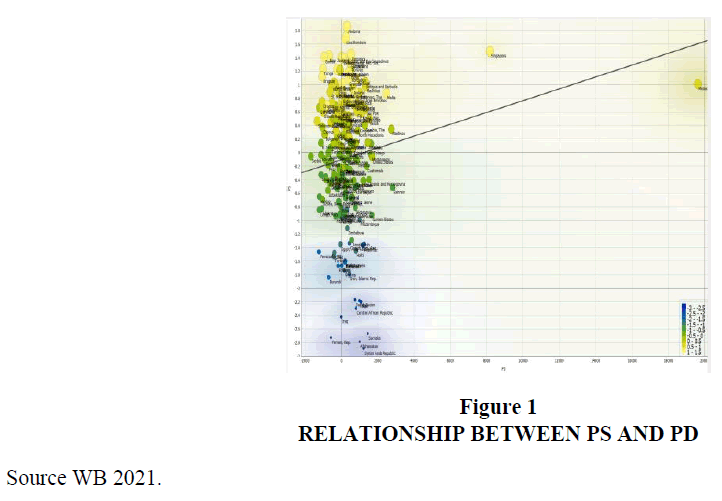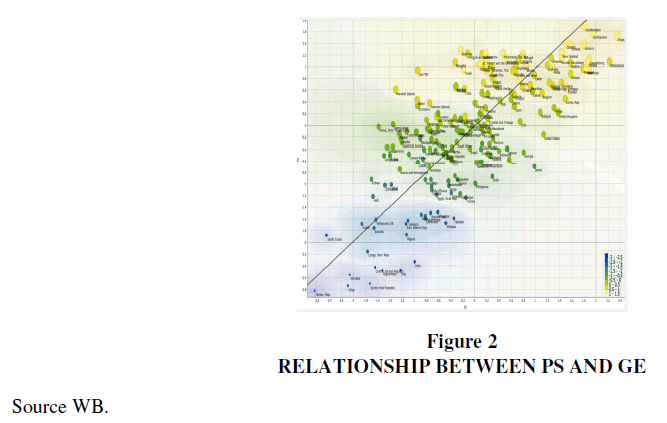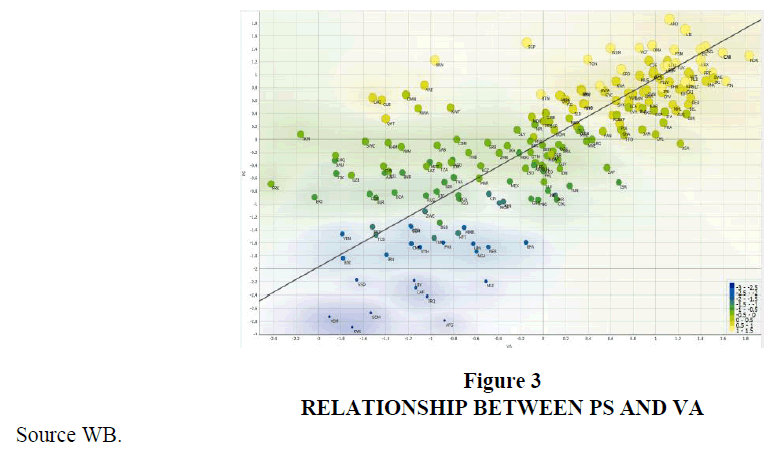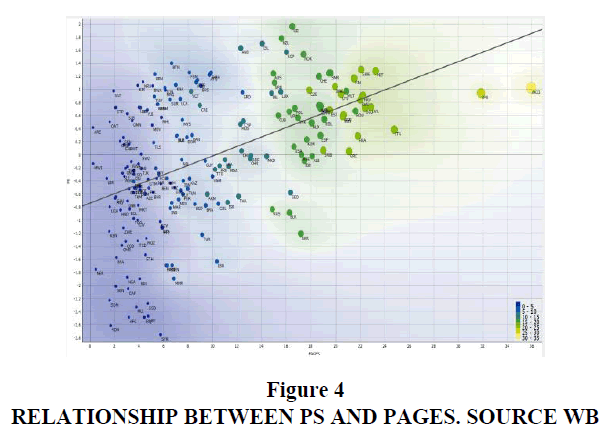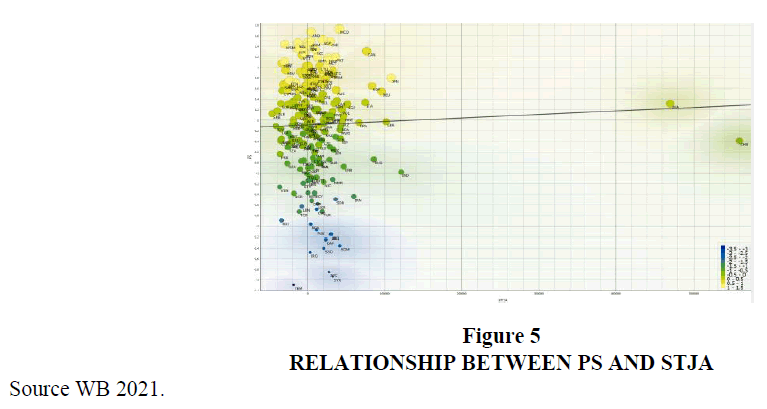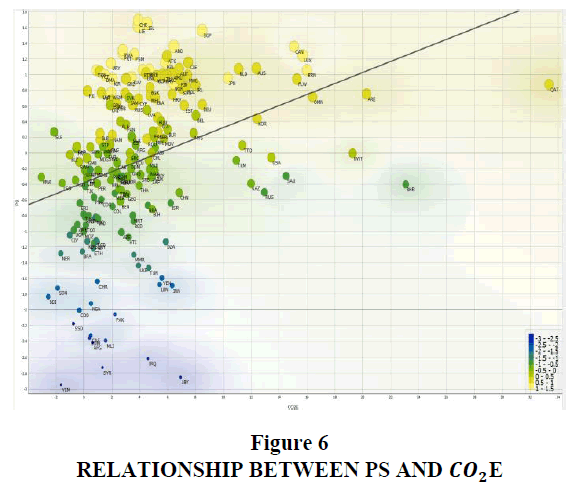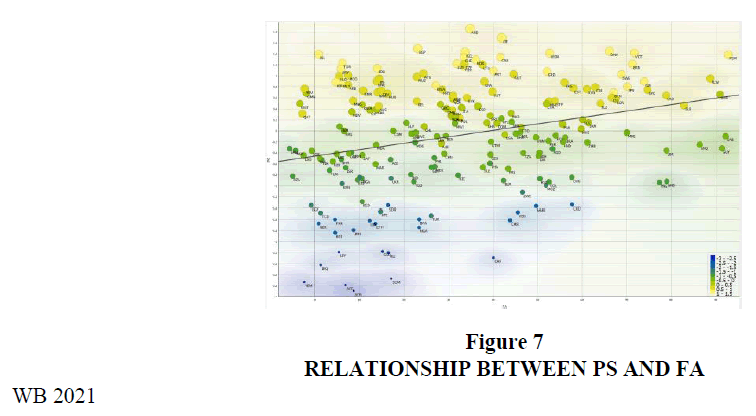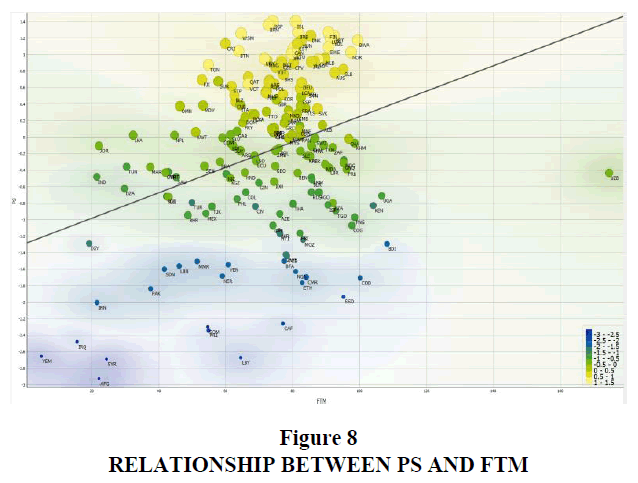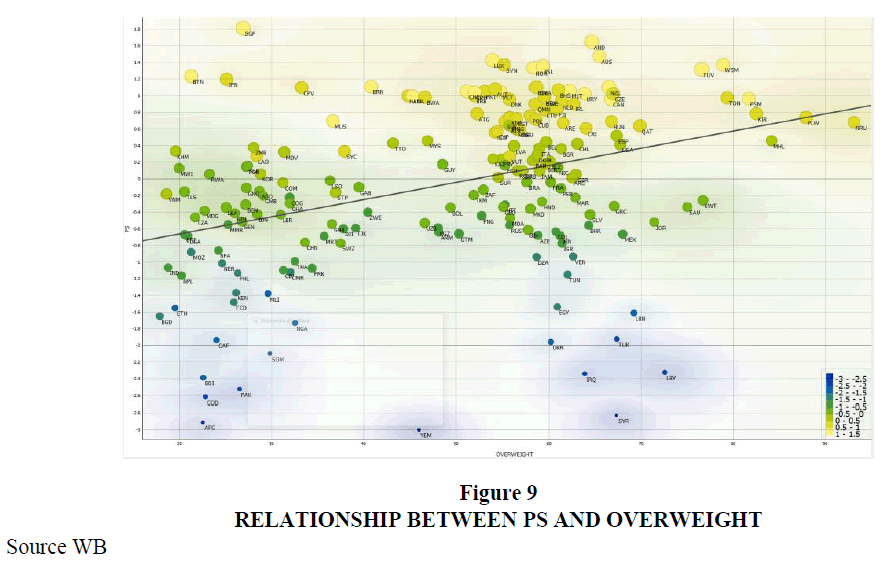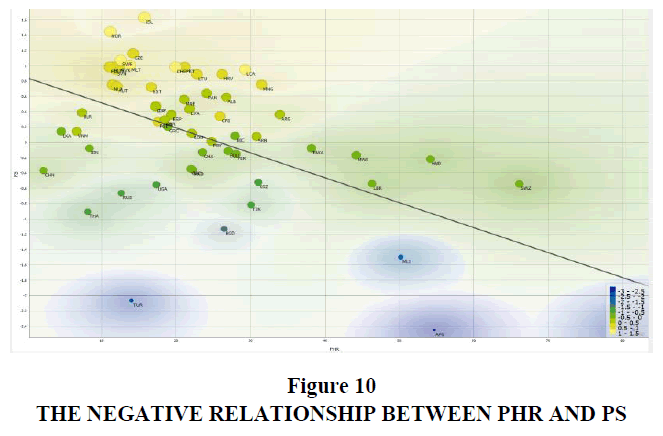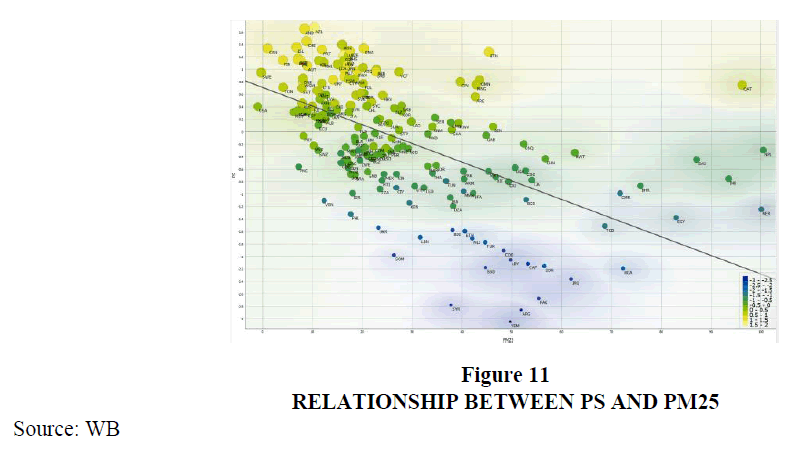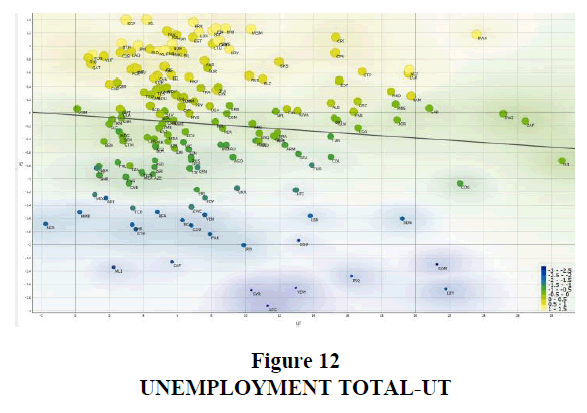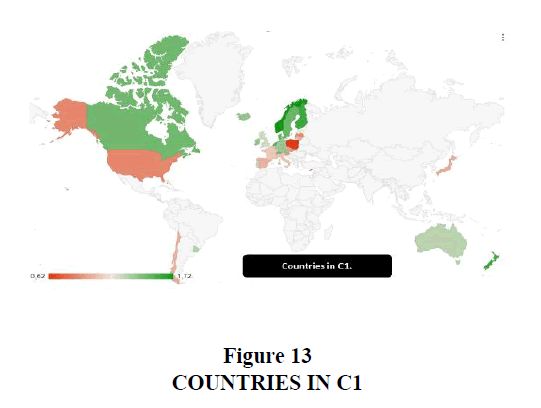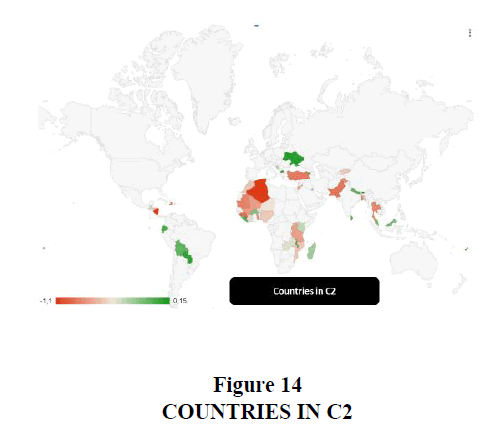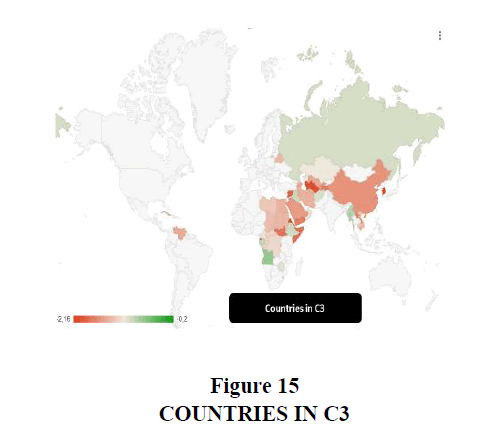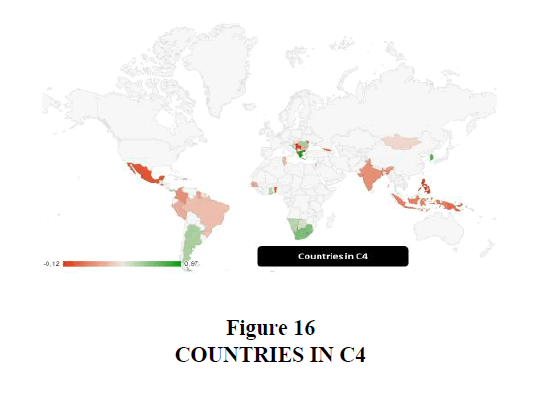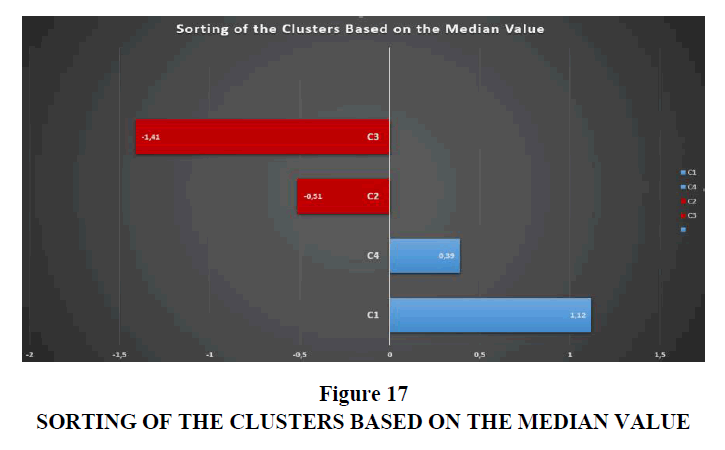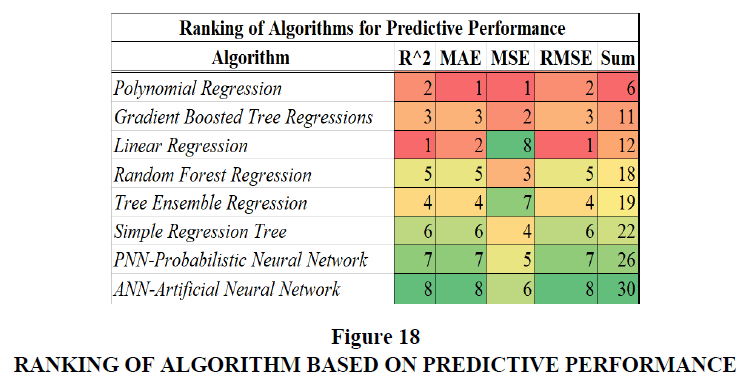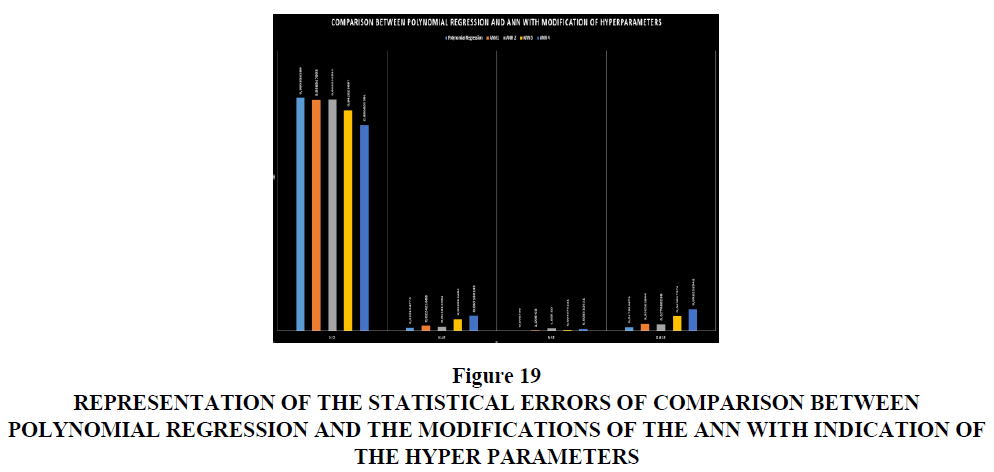Research Article: 2024 Vol: 28 Issue: 2S
The Role of Political Stability in the Context of ESG Models at World Level
Alberto Costantiello, LUM University Giuseppe Degennaro, Casamassima
Angelo Leogrande, LUM Enterprise s.r.l., Casamassima
Citation Information: Costantiello, A. & Leogrande, A.,(2024). The role of political stability in the context of esg models at world level. Academy of Accounting and Financial Studies Journal, 28(S2), 1-34.
Abstract
In this article, we estimate the role of Political Stability and Absence of Violence and Terrorism-PS in the context of Environmental, Social and Governance-ESG data at world level. We analyse data from 193 countries in the period 2011-2020. We apply Panel Data with Fixed Effects, Panel Data with Random Effects and Pooled Ordinary Least Square-OLS. We found that PS is positively associated, among others, to Population Density and Government Effectiveness, and negatively associated, among others, to Research and Development Expenditure and Maximum 5-day Rainfall. Furthermore, we apply the k-Means algorithm optimized with the application of the Elbow Method and we find the presence of four clusters. Finally, we propose a confrontation among eight different machine-learning algorithms for the prediction of PS and we find that the Polynomial Regression shows the higher performance. The Polynomial Regression predicts an increase in the level of PS of 0.25% on average for the analysed countries.
Keywords
Analysis of Collective Decision-Making; General; Political Processes: Rent-Seeking; Lobbying; Elections; Legislatures; and Voting Behaviour; Bureaucracy; Administrative Processes in Public Organizations; Corruption; Positive Analysis of Policy Formulation; Implementation.
Introduction
The following article analyzes the role of PS within the ESG dataset of the World Bank. The ESG models have had a huge diffusion following the spread of sensitivity towards climate change and towards social inclusion and diversity within companies. The idea of a responsible capitalism attentive to the ethical, social, and environmental dimensions was struggled only towards the beginning of the 2000s. It must be considered that for most of the history of western capitalism, there was no type of environmental or social sensitivity. The goal of the companies was simply to produce. Obviously, the negative effects on the environment and on the social dimension are already known by the first industrial revolution. The pollution of rivers, air, soil, the destruction of forests has had immediate effects of the first capitalism. Just as it was immediately understood that capitalism created new forms of poverty. Furthermore, the conditions of workers have always been difficult in the capitalist system since its origins.
These facts were known to the economists of the time who tried to introduce economic policies to avoid adverse effects on the environment, such as in the case of the Pigouvian tax. However, also from a social point of view, since the beginning of capitalism, cooperatives (Ferri & Leogrande, 2022) associations of workers and political parties have been created to defend the rights and freedoms of workers.
In any case, despite the well -known conflict between capital and labour that has always accompanied the development of capitalist societies, there was no innovation except towards the beginning of the 2000s. In fact, until that date it was believed that the state and politics were to intervene externally to create the conditions of a fair, green, and supportive capitalism. Instead, starting from the early 2000s, the perspective has changed. People no longer asked to correct the distortions of capitalism with laws and prohibitions. The question of respect for the ethical, social, and environmental dimensions of capitalism has become internal to companies and part of the managerial sciences.
That is, the issues of ethical, social, and environmental sustainability (Laureti et al., 2023) have gone from the dimension of policy to managerial sciences. In the current cultural approach, therefore, it is believed that politicians must not solve the problems of the ethical, environmental, and social impact of companies, but rather that this competence must be delegated to mangers, who must do it not for higher purposes, but to maximize the value of your company, the reputation, and the ability to acquire new investors, workforce, and consumers.
The element that most of all guided this change by moving the question from politics to managerial sciences was the discovery that companies that have attention to ethical, environmental, and social aspects perform better than companies that simply have an approach guided by the logic of financial profit. This new approach has been the subject of a set of metric studies that have confirmed the initial vision: companies that apply ethical, social and environmental models actually have a greater ability to stay on the market, to acquire customers and to attract the best workers. The result is therefore an internalization in the governance system of the companies of a set of values that would once have been the subject of political and institutional organizations. This condition has changed not only the management, in science and practice, as well as the political debate. In fact, in the western world it is no longer asked to political parties and political organizations to guide the production systems to an ethical, social, and environmental dimension. On the contrary, they are the managers who are invested with ethical, social, and environmental responsibilities and which by operating through production organizations are called to change the orientation of corporations in the sense of ESG models.
Sensitivity to ESG models has increased significantly by pushing companies to propose to investors, workers and consumers, projects increasingly oriented to ESG values. Through ESG orientation, companies have increased the possibility of recovering financial resources by increasing their own endowment of capital. However, this ESG financing race has also led to the development of free riding forms associated with greenwashing.
In any case, the ESG models have established themselves as governance models especially in Big Corps. Furthermore, it must also be considered that the affirmation of the ESG models represents the peak of a set of attempts to introduce social and environmental considerations in corporate governance such as in the case of Corporate Social Responsibility-CSR. Furthermore, from a strictly cultural and ideal point of view, the ESG models seem to be the product of a complex scientific and intellectual processing that began with the development of the stakeholder’s theory (Ferri & Leogrande, 2021). In fact, in the logic of business management oriented to the ESG there are all the typical elements of the stakeholder management approach such as attention to workers, communities, the environment, and constituencies.
However, the ESG model is completely inserted in the dynamics of capitalism, such as the stakeholder model. It therefore represents a type of “adjustment” of capitalism, whose political parties are loaded as well as the managers, to make up for the shortcomings of ethics in the business, attention to the environment and to combat social inequalities. A change in managerial sciences that is in any case consistent with an international politics orientation on which especially European countries have aimed to reduce pollution and promote equality in the labor market. The choice instead of assigning the mangers the task of making the world a more ethical, socially oriented, and environmentally sustainable place seems to echo more forms of Anglo-Saxon pragmatism rather than European political approaches. Although obviously between the European institutional-legislative approach and the Anglo-Saxon decision-making system there are close interconnections.
The variable subject of analysis i.e. PS is representative of political stability, the absence of violence and terrorism. It is a variable that in the ESG database of World Bank is understood as a representative of governance. Obviously in this case it is a public governance, which therefore concerns political institutions, movements, and political organizations at national level, rather than the managerial governance of companies, as instead in the case of traditional ESG models. From this point of view, it should be considered that the ESG dataset of the World Bank is all oriented towards the public dimension and does not take into consideration the impact of the big corps or the private sector on the social, ethical, or environmental dimension.
Political stability from the theoretical point of view should be considered as a positively connected variable with ESG orientation. In fact, the countries that have a high level of PS which also means the absence of terrorism and the absence of political violence, are also the countries that have the highest levels of social and environmental orientation, or the western countries. The PS also tends to be higher in countries that have democratic political systems. It follows that the countries that have anti-democratic, autocratic, vertical, and tendentially liberticidal political institutions could have less likely to successfully apply the models of the ESG type both in the public and private dimension.
The PS variable is a sign of the presence of good governance at the country level. If the PS level is high, then it is very likely that there is already a national level of environmental issues and social issues. PS must not be taken for granted even in the western world. In fact, recent political events have highlighted a difficulty of the western institutions to avoid the manifestation of political violence and terrorism. Especially in the USA, events that have highlighted political and racial violence occurred, also throwing discredit on the entire US democratic system (Costantiello & Leogrande, 2023). Such phenomena occurred in Brazil in the passage of deliveries between Bolsonaro and Lula which seemed to be inspired to the analogue between Trump and Biden. Finally, the violence in France for protests the raising the retirement age promoted by President Macron. These facts show the difficulty of controlling political violence also in the western world and ask the question of the effectiveness of western political and institutional systems (Costantiello & Leogrande, 2023; Leogrande, 2023; Laureti et al., 2023).
Democracy is therefore unable to eliminate political violence, as evident from western societies. However, economic growth also seems to be insufficient to guarantee a reduction of political violence, as in the case of China. In fact, there are many protests of the Chinese against the Xi Jinping government in the management of the Covid-19 pandemic. The protests of the Chinese against the lockdown imposed by the governments were so relevant that many international observers have hypothesized a change in the regime. A hypothesis that did not occur.
The determinants who therefore make the PS value increase are neither strictly institutional, nor purely economic. It therefore derives the need for a more complex analysis, such as the one we have proposed, to verify the presence of connections between PS and ESG models worldwide.
The article continues as below: the second section the methodological aspects that have been used in the analysis, the third section considers the analysis of literature, the fourth section contains the econometric analysis, the fifth section presents the results, the sixth section contains the analysis with machine learning algorithms for the prediction, the seventh section presents the political implications, the limits and the future developments of the research, the eighth section concludes. The appendix presents the results of the metric analysis, tables, and images.
Methodology for the Investigation of the Role of PS in the ESG World Bank Dataset
From a strictly methodological point of view, a strategy based on three elements was implemented, namely:
Econometric regressions
In particular, three different types of regressions were used, namely the Panel Data with Fixed Effects, Panel Data with Random Effects, Pooled OLS model. The econometric analysis was carried out on a sample of 193 countries considered for a period between 2011 and 2020. The World Bank ESG dataset was used for the data analysis. In particular, the value of the PS variable was estimated with respect to a set of variables capable of capturing the elements of environmental, social and "Good Governance" sustainability. However, there are limitations in the model. The econometric analysis conducted is aimed at highlighting the presence of associations between the variables and does not infer any cause-effect relationship. The regression analysis was therefore aimed at identifying the interconnections existing between the variables of the World Bank's ESG model to identify relationships that could suggest economic policy interventions by policy makers.
Clustering with the k-Means algorithm to identify a set of groupings
A clustering with the k-Means algorithm was subsequently created to identify the presence of groupings within the dataset. The k-Means algorithm requires the identification of a criterion to optimize the number of clusters. In this sense, Elbow's method was used. Alternatively, another method could have been used to select the optimal number of clusters, i.e. the Silhouette coefficient method. The Silhouette coefficient is a number that is assigned to the clustering. A Silhouette coefficient is assigned to each k. The choice falls on the k associated with a high value of the Silhouette coefficient. However, the application of the Silhouette coefficient would have led to the choice of a number of k equal to 2 considered insufficient to give a representation of the complexity of the analysed dataset. For these reasons, the Elbow method was preferred to the Silhouette coefficient method. Using Elbow's method, the value of k was fixed at 4. The composition of the four clusters was then analysed from a socio-economic point of view. The result is a wide heterogeneity of the 193 countries considered with highly variable PS levels which highlight the presence of significant distinctions between countries at the level of political and democratic institutions. Furthermore, Western countries are also characterized by high levels of PS, while many of the newly developed and newly industrialized countries have low PS levels. The data highlights the presence of opposing blocks and defined from a geographical point of view from the point of view of the distribution of PS. A condition that also from a qualitative-quantitative point of view highlights the division of the global economy between countries that tend to be democratic and countries that tend to be autocratic.
Machine Learning and Predictions
The use of machine learning algorithms for predictions has made it possible to identify the future value of the PS variable for a set of countries considered. Eight different machine learning algorithms were chosen. The algorithms were analysed from the point of view of performance based on their ability to maximize the R-squared value and minimize statistical errors, i.e. Mean Average Error-MAE, Mean Standard Error-MSE, Root Mean Standard Error-RMSE. The best performing algorithm from a metric point of view was chosen as the best predictor. To further verify the efficiency of the prediction, the predictive performance of the best predictor algorithm was also analysed in the light of a comparison with a deep learning algorithm or the ANN-Artificial Neural Network. Various comparisons were made by modifying the number of ANN neurons and the result shows that for the data entered the analysis, deep learning has a reduced predictive efficiency.
The combination of the three methodologies analysed highlights the multiple role that PS has in the context of ESG data, at a global level, and what are the future growth prospects of the value of PS.
Literature Review
A summary of the scientific literature relating to the role of PS is presented below in the determination of international economic and political structures.
PS and the Environment
Political stability tends to play a positive role in reducing pollution globally. In fact, the countries that have a greatest orientation to PS tend to also have a regulatory system that reduces the probability of companies to pollute. If there is an increasing level of political instability, then it is likely that violence and terrorism prevent the population and politicians from concentrating on environmental issues. On the contrary, if the PS value is high, as happens for example in western countries, then the legislator and policy makers can dedicate greater attention to environmental issues. In addition, it should also be considered that excess pollution at national level could be considered as an example of bad governance and therefore it could be the motivation of political instability, political violence and terrorism. There is a positive relationship between PS and the improvement of environmental quality (Citil et al.,2022; Adebayo et al., 2022) Arable land and agricultural production are positively associated to PS in the case of Egypt ( Carlson, 2022). PS reduces the level of CO2 emissions in BRICS countries (Farooq et al., 2023). Low levels of PS reduce environmental quality in 16 MENA countries (Mrabet et al., 2021). PS has a positive impact in reducing the environmental degradation in four Asian countries (Pata et al., 2022).
PS and Economic Growth and Economic Development
The most advanced countries from an economic point of view tend to have high PS levels. However, there are some significant exceptions to this rule. For example, the US also being an economically advanced country have lower PS levels compared to the average of developed countries, due to a set of political tensions between democrats and republicans, and also for racial issues that contrast the African American community to the culture of supremacy of whites. However, there is no doubt that the countries that increase the value of PS also tend to grow from an economic point of view. The reasons refer above all to the ability of a country with a high PS of attracting FDI. In addition, a country with a growing level of PS tends to be attentive to the question of the validity of private property contracts and therefore best guarantees foreign investors. PS is positively associated to economic growth in developing 8-D8 countries i.e. Bangladesh, Egypt, Indonesia, Iran, Malaysia, Nigeria, Pakistan, and Turkey (Arif et al., 2021). There is a positive relationship between PS and financial development in the case of Turkey (Calıskan, 2019). PS has a positive effect on Foreign Direct Investments-FDI (Vasilyeva & Mariev, 2021). PS has a positive impact on economic growth, diplomatic activity and FDI in Iraqi Kurdistan (Biro, 2019). PS is positively associated to international tourism development in six South Asian countries (Hasan et al., 2022). PS is positively associated to economic growth in South Asian countries (Shahab & Mahmood, 2022). Similar results have been found in the case of Uzbekistan (Komil, 2022). PS has a positive impact in attracting FDI in democratic Middle East and North African-MENA countries (Musibah, 2021). PS has a positive impact on economic growth in BRICS countries (Kesar et al., 2022).
PS is negatively associated to inflation for modest levels of the informal sector; the relationship turns positive in the case of an increase in the shadow economy (Mazhar & Jafri, 2017). PS and democratization do not have a positive effect on the investment in African mobile market (Moshi & Mwakatumbula, 2017). PS is positively associated to FDI in 16 competitive Asian Pacific countries (Rashid et al., 2017).
PS and Governance
PS is a variable that summarizes the “good governance”. In fact, high levels of PS can be considered as an indicator of an illuminated government from a public point of view. However, PS is not the only element that defines a good governance. There are also others such as Government Effectiveness, Rule of Law, Quality of Regulation and Voice and Accountability. Therefore, it is necessary to consider the connections among these variables to identify the specific contribution of PS. However, the political structure of a country is not only given by the dimension of its governance. There are also a set of cultural and social elements that define the participation of the population in the democratic process. In this sense, the level of education for civil participation in democratic countries is significant. In fact, to increase the value of PS especially in democratic countries it is necessary to invest in the creation of a culture of institutions and democracy that can also involve a reduction in political conflict in the event of elections. PS, control of corruption, and rule of law are positively associated in the case of Indonesia (Tjandrasa, 2021). There is a negative relationship between party switching and PS in the case of Nigeria (Okolie, 2021). The increase in citizenship partecipation and improvements in education can promote PS in Nigeria (Koku, 2017). If the percentage of youth population in adult population exceed 19% then corruption has a negative effect on PS (Farzanegan & Witthuhn, 2017). There is a positive relationship between political election and political violence in Nigeria (Egobueze & Ojirika, 2017). Inclusive democratic education can promote PS in Nigeria (Obot, 2019).
Miscellaneuos
Furthermore, it must be considered that the PS value can also depend on other factors. For example, from the consumption of families. In fact, if the consumption of families is considered as a proxy of the income value, then it follows that the growth of the PS value should also increase the value of the consumption of families. There is a positive relationship between PS and household consumption (Ihsan, 2022) in Islamic countries. Since PS reflects a set of values of public and institutional life, it follows that the PS value can also be influenced by religion. In fact, religion can prescribe moral precepts that can impact the PS value positively (Akhmedov & Azizova, 2020). Finally, there is a relationship between the happiness of the population and the value of PS. In fact, in countries where the PS level is growing, there is also greater freedom of the population to participate in political life. It follows that the growing value of PS can also act in the individual sphere by creating the conditions for an increase in both individual and public happiness (Canini & Yu, 2020). The countries where there is terrorism or political violence in fact are characterized by the dominance of negative feelings in public life that can have an impact also in the individual sphere of the population.
The Econometric Model for the Estimation of the Value of PS
Below is a metric analysis for estimating the value of PS based on the variables of the ESG dataset of the World Bank. The data were analysed using three econometric models, namely the Panel Data model with Fixed Effects, Panel Data with Random Effects and Pooled OLS. The data analysed refer to 193 countries in a period of between 2011 and 2020. The World Bank's ESG dataset consists of 67 variables. The variables were not chosen normatively. We have chosen the variables through the application of a metric method i.e. the identification of the p-value. The use of a strictly metric model for the choice of variables was possible considering that the variables of the World Bank's ESG dataset are consistent from a theoretical point of view. In fact, since the World Bank built the ESG dataset, we decided not to choose normatively the variables of the model, preferring certain variables rather than others. In fact, the variables are consistent from a theoretical and methodological point of view, and therefore it was possible to use the p-value as the unique criterion for selecting the variables.
We must also consider that in the proposed model no reference is ever made to the presence of cause-effect relationships among the variables. Since we have not carried out any test for the control of causal effects, then it is not possible to state that a certain variable causes a variation in another variable. In fact, the following part refers exclusively to the dimension of the associations among variables, whether positive or negative, without ever considering the question of the cause-effect relationship.
In fact, adopting a causal type of approach would have required the use of other metric type instruments, such as for example Granger Causality, and would also have involved the use of a different epistemological type of approach i.e. a deterministic one. On the contrary, in our analysis we exclusively consider associations among variables, without ever posing the question of causality.
The social sciences are in fact a dangerous field for experimenting with forms of causality. And the probability of error tends to grow with the complexity of the models. To avoid this epistemological trap, we have chosen to limit ourselves to analysing the positive and negative associations between the variables, identifying any reasons that could illuminate these relationships.
In particular, the following econometric equation has been estimated or:


We found that PS is positively associated to the following variables:
Population Density-PD
It is a variable that considers the population divided by the land area in square kilometres. By population, it takes into consideration all residents regardless of citizenship. There is a positive relationship between the value of the population per square area and the value of PS. This relationship indicates that the countries characterized by a higher population density are also the countries that have a higher level of PS. In particular, many small countries with high levels of population densities also have high levels of PS. Among these countries, we can consider Monaco, Singapore, Malta, San Marino, South Korea, the Netherlands, Japan, the United Kingdom. Of course, these are not only small countries (Figure 1). In addition, these countries have a significant per capita income, and highly evolved economic and institutional systems (World Bank).
Government Effectiveness-GE
It is a variable that consider the perceptions of public services, the quality of the civil service and the degree of its independence from political pressures, the quality of policy formulation and implementation, and the credibility of the government’s commitment to such policies (World Bank). There is a positive relationship between the value of PS and the value of GE. For example, some countries that have high value of PS and high value of GE are: Liechtenstein, New Zealand, Singapore, Iceland, Norway, Luxembourg, Switzerland, Japan. Countries in which there is a high level of PS also have greater public services and a more efficient government. In a certain sense, there is a one-to-one relationship between the two variables i.e. PS and GE. In fact, if countries have high levels of GE in producing goods and services, this also results in greater satisfaction of the population and therefore a reduction in political instability and terrorism. On the other hand, countries that in some way deny rights, freedoms and public services to the population show higher levels of political violence. Western countries are certainly not exempt from the risk of political instability. The presence of phenomena such as, for example, inflation and social inequality, as well as the discrimination of the labour component of the GDP compared to the capital share can lead to the emergence of forms of political violence. A case of this is represented by the protests of the French against the raising of the retirement age in March 2023 which questioned the economic policies of President Macron (Figure 2).
Voice and Accountability-VA
It reflects perceptions of the extent to which a country's citizens are able to participate in the selection of their government, as well as freedom of expression, freedom of association and freedom of the media (World Bank). In particular, there is a positive relationship between the PS value and the VA value. The countries where citizens have a greater possibility of actively participating in the development of national political life and in the democratic system are also characterized by a higher level of PS. Democratic participation in fact reduces political violence and creates greater stability. If citizens know they can participate in political-institutional phenomena, if they can influence public decision-making processes in some way, then they have less need to use political violence as a tool to assert their individual positions. Notably, among the countries that have high levels of VA and high levels of PS are the following: Norway, Finland, New Zealand, Switzerland, Denmark, the Netherlands, Sweden, Luxembourg, Canada and Austria. Evidently they are all Western countries and in a particular way from Central-Northern Europe. In fact, it is not enough for a country to be democratic to have high values of VA and PS. For example, the USA has average VA values and low PS values. The values of VA and PS for the USA are very far from the corresponding values of the economies of Northern European countries. It is therefore necessary to work on the principles of democratic participation first in Western countries and then to create the conditions for a dynamic development of international projection of democratic political institutions (Figure 3).
Population Ages 65 and above-PAGES
It is a variable that considers the population aged 65 or over as a percentage of the total population (World Bank). There is a positive relationship between the PAGES value and the PS value. It follows that the countries in which the average age of the population tends to be higher are precisely the countries with a high value of political stability. PS also becomes an indicator of social peace within a specific country and of the presence of a model of intergenerational solidarity which allows the younger generations to take care of the older ones in a political context oriented towards care and welfare. Countries that have a high level of political and terrorist tension are also countries where welfare state institutions are lacking, which lack efficient health systems and pension aids that can lead to an increase in the life expectancy of the population. There are countries that have high levels of PAGES and PS, namely: Monaco, Japan, Italy, Finland, Portugal, Bulgaria, Greece, Germany, Croatia, Latvia (Figure 4).
Scientific and Technical Journal Articles-STJA
Scientific and technical journal articles refers to the number of scientific and engineering articles published in the following fields: physics, biology, chemistry, mathematics, clinical medicine, biomedical research, engineering and technology, earth and space sciences (World Bank). There is a positive relationship between the PS value and the number of articles published in technical and scientific journals. This relationship depends on the fact that the possibility for countries to invest in research and development also depends on the growth of human capital and intellectual capital. The possibility of making human capital flourish depends on the services offered to the population. In conditions of low unemployment, recognition of democratic rights and freedoms, the population renounces the exercise of forms of political violence. In this context, a country can better study science and culture and invest in scientific and technological production with the possibility of further improving its economic and social condition. Among the countries that are leaders in scientific production there are some that also have high PS values, i.e. the USA, Germany, Japan, the United Kingdom, Russia, Italy, South Korea, France (Figure 5).
CO2 Emissions-COE
It is a variable that considers carbon dioxide emissions as those deriving from the combustion of fossil fuels and the production of cement. They include carbon dioxide produced during the burning of solid, liquid and gaseous fuels and gas flaring. There is a positive relationship between PS and CO2 Emissions in the analysed context. Countries that have high levels of PS are also the most industrialized and most polluting countries (World Bank). Although the Western world has begun a process to reduce polluting emissions and fight climate change, the change in the industrial system and the consumption habits of the population is slow. It follows that at present there is a positive relationship between PS and CO2 emissions. However, it is probable that the adoption of environmental economic policies could lead to an inversion of the relationship existing between PS and CO2. In particular, there are countries that have high levels of PS and CO2 or Canada, Luxembourg, Austria, USA, South Korea, Japan, the Netherlands, Singapore, Belgium, Germany (Figure 6).
Forest Area-FA
It is a variable that considers the percentage of forests on the total territory available at national level. There is a positive relationship between the value of the percentage of FA and the value of PS (World Bank). This relationship is because most of the countries that have high PS levels are Northern European countries, i.e. a geographical area characterized by an intense presence of forest areas. Obviously, this relationship must be understood from a strictly associative point of view without considering in any way the presence of cause-effect relationships. Among the countries with high levels of PS that also have high results in terms of AF are: Finland with an amount of 73.72%, Sweden with an amount of 68.69%, Japan with an amount of 68.40%, South Korea with an amount of 64.41% and Latvia with an amount of 54.80% (Figure 7).
Ratio of female to labour force participation rate-FTM
It is calculated by dividing the female labour force participation rate by the male labour force participation rate and multiplying by 100 (World Bank). There is a positive relationship between TFM and PS. The positive relationship between the TFM value and PS is because most of the countries that have high PS values are from Western countries, and especially from Northern Europe. Northern European countries have a more open type of society, which is able to achieve greater integration of women within society. Political stability therefore tends to increase in the presence of a marked orientation towards gender parity and equal opportunities between women and men. There are countries that have high levels of PS and of TFM, namely Norway, Luxembourg, Finland, United Kingdom, Denmark, Canada, New Zealand, and the Netherlands (Figure 8).
Prevalence of overweight-Overweight: is a variable that considers the presence of overweight as % of the adult population. There is a positive relationship between the PS value and the overweight value (World Bank). Countries that have higher levels of PS also have higher levels of overweight. The positive relationship is because the countries with high PS levels are Western countries. In Western countries, there has been a growth in the number of overweight and obese people. The growth of gross domestic product also generates growth in the value of overweight people. The highly evolved food industry in Western countries tends to create nutritional models, which induce the population to adopt behavioural habits, which lead to overweight and obesity. There are countries for which the value of PS and overweight people are high, namely: USA, Malta, New Zealand, Austria, Israel, Canada, and United Kingdom (Figure 9).
Fertility Rate-FR
It is a variable that considers the number of children that would be born to a woman if she lived to the end of her childbearing years and gave birth at age-specific fertility rates for the specified year (World Bank). There is a positive relationship between the PS value and the fertility rate value. However, it must be emphasized that the values of the fertility rate coefficients estimated using both the Fixed Effects model, the Variable Effects model, and also the Pooled OLS model are close to zero. The figure is partly counterfactual since in Western countries, which have the highest levels of PS value, the fertility rate value is lower than in countries that have low PS levels.
There is a variable for which the value of the coefficient is equal to zero:
Strength of Legal Rights Index-SLRI
Measures the degree to which collateral and bankruptcy laws protect the rights of borrowers and creditors and thereby facilitate lending. The index ranges from 0 to 12, with higher scores indicating these laws are better designed to expand access to credit (World Bank). It must be considered that the value of the coefficients calculated with the models with Fixed Effects and Variable Effects, together with the Pooled OLS model, show a heat equal to zero. Therefore, it is not clear how the variable influences the PS value, even though it is statistically significant from a metric point of view.
We found that PS is negatively associated to the following variables:
Poverty Headcount Ratio at National Poverty Lines-PHR
It is an index that calculates the percentage of the population living below the national poverty line. National estimates are based on population-weighted subgroup estimates from household surveys. There is a negative relationship between the PHR value and the PS value (World Bank). If the percentage of the population living below the poverty line increases then the value of PS decreases. The growth in the number of poor causes political instability, political violence and terrorism to grow. The poor therefore tend to organize and engage in forms of political activism to change the redistributive policies of the population. The negative relationship between PHR and PS is also because the countries that have the highest levels in terms of PS are the western countries that have high per capita income levels and a low concentration of the poor as a percentage of the population (Figure 10).
PM2.5 Air Pollution-PM25
It is defined as the average level of exposure of a nation's population to concentrations of airborne particles measuring less than 2.5 microns in aerodynamic diameter, which are capable of penetrate deep into the respiratory tract and cause serious harm to health (World Bank). There is a negative relationship between PM25 and the PS value. The growth of the pollution value is negatively associated with the PS value. The countries that have low levels of PS are also the countries that pollute the most. Among the countries that pollute the most there are in fact Nepal, Niger, Qatar, India and Saudi Arabia, which are countries that have low levels in terms of PS (Figure 11).
Life Expectancy at Birth-LEB
Indicates the number of years a new-born would live if the prevailing patterns of mortality at the time of its birth remained the same throughout life. There is a negative relationship between the value of life expectancy at birth and the value of PS (World Bank). This relationship seems to go against common sense. In fact, since the countries that have high levels of PS are Western countries, which also have high levels in terms of LE, a positive value of the relationship between PS and LE should result. On the contrary, if we analyse the values of the regression coefficients both with fixed effects models and with variable effects and with the Pooled OLS model, it is possible to verify the following values: -0.00592437; -0.002368; -0.002144.
Income Share Held by Lowest 20%-IS20
The percentage share of income or consumption is the share belonging to population subgroups indicated by deciles or quintiles. Percentage odds by quintile may not add up to 100 due to rounding. In this case reference is made to the income share held by lowest 20%. It follows that if the number of people who have low incomes increases, then the value of PS increases (World Bank). In fact, if the number of poor people increases then political violence, terrorism and political instability also increase. It follows that implementing economic policies that reduce the percentage of people with low incomes can be a tool for political stability and for the fight against violence and terrorism. In this sense, economic policies aimed at creating universal incomes can be very useful in preventing the protests of people with low incomes from manifesting themselves in the form of violence, terrorism or political instability.
Unemployment Total-UT
To the share of the labour force that is out of work but available and looking for work. There is a negative relationship between UT and PS. The increase in UT is negatively associated with the growth of the value of PS (World Bank). The creation of a mass of unemployed tends to create the conditions for political instability, political violence and terrorism. For these reasons, it is in the interest of governments to reduce the unemployment rate in such a way as to create the conditions for growth in the value of PS and to avoid the manifestation of political violence and terrorism. Low UT would therefore have not only an economic role, i.e. increasing the number of people who actively participate in the construction of the Gross Domestic Product, but also a role connected to public order, i.e. preventing the masses of unemployed from generating politicians who are dangerous and violent (Figure 12).
Research and Development Expenditure-RDE
It is a variable that takes into account gross domestic expenditure on research and development (R&D), expressed as a percentage of GDP (World Bank). This variable includes both capital expenditure and current expenditure. In particular, four different types of providers are identified, namely: the government, higher education, the non-profit, and the private for-profit sector. Research and development means basic research, applied research and experimental development. There is a negative relationship between the value of R&D expenditure as a percentage of GDP and the value of PS. This relationship is due to the fact that even countries that have low levels of PS value may be able to invest within the R&D sector.
Maximum 5-Day Rainfall-M5DR
It is a variable that takes into consideration rainfall. There is a negative relationship between the growth of precipitation and the PS value. This relationship can be understood as a mere geographical condition. However, it is very probable that climate change could change this trend in the future (Table 1).
| Table 1 Synthesis of the Main Results with the Econometric Models | |||||||
| POOLED OLS | RANDOM EFFECT | FIXED EFFECT | AVERAGE | ||||
| Coefficient | p-Value | Coefficient | p-Value | Coefficient | p-Value | ||
| const | -0,191805 | *** | -0,552684 | *** | -0,554567 | *** | -0,43302 |
| A11 | 0,0292833 | *** | 0,0113449 | *** | 0,00982074 | *** | 0,01682 |
| A20 | 0,000146389 | ** | 0,00015938 | *** | 0,00016503 | *** | 0,00016 |
| A22 | 0,00601321 | *** | 0,00809397 | *** | 0,00744952 | *** | 0,00719 |
| A27 | 0,464102 | *** | 0,467872 | *** | 0,469419 | *** | 0,46713 |
| A31 | -0,0272072 | *** | 0,00801497 | *** | 0,00857515 | *** | -0,00354 |
| A34 | -0,00592437 | *** | -0,002368 | *** | -0,0021446 | *** | -0,00348 |
| A37 | -1,13522 | *** | -0,979601 | *** | -0,967782 | *** | -1,02753 |
| A46 | -0,00652613 | *** | -0,0014341 | *** | -0,001112 | *** | -0,00302 |
| A48 | 0,0387529 | *** | 3,87E-02 | *** | 0,027737 | ** | 0,03507 |
| A49 | 6,33E+00 | *** | 9,97E+00 | *** | 0,00041396 | *** | 5,43327 |
| A50 | -0,00249124 | * | -0,0013754 | ** | -0,00136056 | ** | -0,00174 |
| A51 | 0,00532345 | *** | 0,00135757 | *** | 0,0010456 | *** | 0,00258 |
| A54 | 0,00435786 | *** | 0,00238816 | *** | 0,0022645 | *** | 0,00300 |
| A58 | -0,346785 | *** | -1,11E-01 | *** | -0,101655 | *** | -0,18641 |
| A62 | -6,67E-02 | * | 6,49E-02 | ** | 8,02E-02 | *** | 0,02614 |
| A63 | 0,000693604 | *** | -0,0003191 | *** | -0,00035963 | *** | 0,00000 |
| A65 | -0,0222114 | *** | -0,0109122 | *** | -0,00768964 | * | -0,01360 |
| A67 | 0,25666 | *** | 0,142605 | *** | 0,132027 | *** | 0,17710 |
Clusterization with k-Means Algorithm Optimized with the Elbow Method
In the following section, we apply a cluster analysis with the k-Means Algorithm optimized with the Elbow Method. We found the following clusters:
Cluster 1
San Marino, France, Palau, Estonia, Malta, Ireland, United Kingdom, Andorra, Uruguay, Belgium, Barbados, Marshall Islands, Portugal, Costa Rica, Iceland, Australia, Austria, Liechtenstein, Germany, Canada, Micronesia, United States, Netherlands, Chile, Spain, Cyprus, Finland, Luxembourg, New Zealand, Switzerland, Denmark, Japan, St. Lucia, Sweden, Slovenia, St. Kittis and Nevis, Norway, St. Vincent and the Grenadines, Italy, Czechia, Cabo Verde, Lithuania, Slovak Republic, Kiribati, Tuvalu, Dominica, The Bahamas, Poland, Mauritius, Monaco, Latvia. The median value of the cluster is 1.12 (Figure 13).
Clusterization with the k-Means algorithm optimized with the Elbow method.
This is the cluster that has the highest level of PS compared to the others. As can be seen, the countries in C1 are mainly Western countries located essentially in North America, Western Europe and in the Oceania area. However, there are exceptions such as the case of Chile and Uruguay in Latin America and the case of Japan in Asia. However, as can be seen in the following figure, Southern Europe, Japan, the Baltic countries, the USA and Chile still have low values compared to the average of the belonging cluster. Certainly, the last country in the cluster is Poland, which has long been crossed by a sustained political debate regarding the opportunity to remain in the European Union. However, these data refer to 2020. Certainly today, in the light of the Russian-Ukrainian conflict, the political debate about the opportunity to remain in Europe has ended both in Poland and in the other Eastern European countries. Furthermore, paradoxically, the USA also has a low value in the C1. In fact, the political, social and racial violence in the USA has called into question the democratic values of the country, especially following the attack on Capitol Hill by Trump supporters. Furthermore, Trump's ongoing campaign to delegitimize Biden's victory also played an important role in reducing the value of PS, creating a conflict between Democrats and Republicans and undermining the trust in American institutions. However, we must always consider that either Poland either the USA are in any case part of the C1, which is the leading cluster by value of PS. In other words, these countries have very high levels of PS compared with other countries at global level. However, in an intra-cluster analysis the USA, Poland, Japan, Southern Europe, the Baltic countries and Chile certainly have lower values than the countries of Northern Europe, Canada, Australia and New Zealand.
Cluster 2
Algeria, Bolivia, Paraguay, Mauritania, Bhutan, Singapore, North Macedonia, Guinea-Bissau, Malawi, Ukraine, Guinea, Fiji, Thailand, Bosnia and Herzegovina, Burkina Faso, Liberia, Pakistan, Togo, Ecuador, Brunei Darussalam, Haiti, Zambia, Jordan, Mali, Kenya, Sierra Leone, Tanzania, Sri Lanka, Nicaragua, Morocco, Malaysia, Mozambique, Nepal, Türkiye, Kuwait, Niger, Armenia, Guatemala, Cote d’Ivoire, Madagascar, Uganda, Comoros, Maldives, Nigeria. Bangladesh, Lebanon, Kyrgyz Republic, Honduras. The median value of the cluster is -0.51 (Figure 14).
Clusterization with the k-Means algorithm optimized with the Elbow method.
Cluster 2 is the third in order considering the median value. It is a cluster essentially made up of African, Eastern European, Central and South American and Asian countries. These countries have a very high level of political conflict. As indicated in the figure below the countries in green tend towards the upper cluster, which is C3 while the countries that are indicated in red tend towards the lower cluster, which is C4 (Figure 14). As much as the countries in this cluster are characterized by political instability, some lean towards forms of terrorism and political violence. Among the most dangerous countries in this sense are Algeria, Pakistan, Nicaragua and Turkey. The data analysed stop at 2020 and therefore do not take into consideration the evolution of the Russian-Ukrainian conflict, nor the Sino-American tensions, and the protests in Hong Kong. Of particular interest is also Turkey, a country in which despite the persistence of President Erdogan in power, there is still a lack of PS. In fact, Turkey is classified as a nation characterized by political instability. Another element of political destabilization is Pakistan. Pakistan is in fact a state characterized by a set of political tensions both towards India and towards the other countries in the area. As is evident, the majority of these countries are not true democracies, and on the contrary, they tend to be essentially anti-democratic regimes, autocracies. They are essentially poor countries, with very low per capita income. There is therefore a relationship certainly between countries that have high levels of political stability and the value of economic growth. The development of forms of political violence and terrorism prevents countries from growing and developing both from a political-institutional point of view and from an economic point of view. Countries therefore remain trapped in a paradoxical condition where the lack of elements of liberal democracy prevents economic development and the lack of economic development creates the conditions for forms of political violence, instability and terrorism. It is therefore necessary that the countries that have low values in terms of PS invest both in democratic freedoms and in the development of the private economy in order to be able to access higher levels of quality of life for the population.
Cluster 3
Gabon, The Gambia, Cameroon, Russian Federation, Iraq, Angola, United Arab Emirates, Oman, Myanmar, Cambodia, Venezuela, Afghanistan, Qatar, Congo Rep., Egypt Arab Rep., Burundi, Rwanda, North Korea, Turkmenistan, Central African Republic, Libya, Somalia, Zimbabwe, Equatorial Guinea, Syrian Arab, Ethiopia, Uzbekistan, South Sudan, Saudi Arabia, Sudan, Bahrain, Lao PDR, Eswatini, Iran, Yemen, Chad, Congo Dem. Rep., Belarus, Tajikistan, China, Vietnam, Azerbaijan, Djibouti, Cuba. The median value of the cluster is -1.41 (Figure 15).
Clusterization with the k-Means algorithm optimized with the Elbow method
As evident from the graphic representation, it appears that the countries belonging to this cluster are essentially African, Middle Eastern and Eurasian countries. C3 countries are the last in terms of PS values worldwide (Figure 15). Looking at the map of these countries, the cases of China and Russia certainly stand out. In fact, China and Russia are considered as countries characterized by political instability and the presence of political violence and terrorism. The case of China is particularly relevant. In fact, coherently with the theory of states of economic development, a condition should have been created which should have led to a growth in awareness of democratic ideals among the population. On the contrary, the import growth of per capita income in China has not also led to a growth in political stability and has exacerbated the struggle of the Communist Party's ruling class to stay in power. Despite the efforts and investments that especially the USA have made towards China to allow the Chinese to enter the World Trade Organization-WTO and to participate in international supply chains, the result from a political-institutional point of view is poor.
The Chinese do not intend to give up their institutions characterized by a top-down structure of control that suppresses individual and collective freedoms and leads the population to practice forms of political violence. Furthermore, the condition in China has also worsened as a result of Covid-19. In fact, the government's decisions to use drastic measures against the population to avoid infections have created many protests among the population. Finally, the choice to confirm Xi Jinping in power has created further critical conditions for a country that seems to have abandoned both the path of democratic freedoms and the path of economic growth - as evidenced by the reduction in the GDP growth rate. The Chinese economy could therefore slowly come to a standstill, with a growth of domestic inequality, and this could lead to a further growth of political instability.
Some considerations are also due for Russia. After the end of the Soviet regime, which collapsed on itself, Russia also received important aid from the West and from the international community. Initially it seemed that Russia wanted to embark on the path of democracy. Later, however, the growth of the power of the oligarchy led Russia to look to the past instead of preferring the future. The consequences have resulted in a whole series of military aggressions that Russia has carried out against countries belonging to the former Soviet Union up to the attack against Ukraine. Russia is also home to numerous hacker groups who attack Western companies and institutions. It is difficult to say what would have happened to the Russian economy if instead of choosing the path of oligarchy and autocracy it had chosen the path of liberalism and democracy. Probably per capita income would have gone up, average life expectancy would have increased, and women would have been more integrated into society.
Both cases, that of Russia and that of China, show that the fact of potentially having the resources to access economic growth and democracy does not necessarily lead to the development of economic and political systems. Furthermore, both cases also show the ingenuity of the West, which in an attempt to bring democracy and progress ends up offering financial resources, technology and military means to its enemies.
Iran, on the other hand, deserves some separate considerations. Iran is also a country that could participate in the top positions of the global economy. However, the regime in Tehran prevents economic development and freedom for its own population. However, unlike China and Russia, Iran has not received significant investments from the West. Therefore, it turns out a more consistent case of autocracy than the case of Russia and China.
Certainly, the combination of Russia, China and Iran currently constitutes one of the most dangerous conditions of international politics, which could undermine not only the safety of the population but also the entire world order and peace.
Cluster 4
Grenada, Moldova, Nauru, Korea del Sud, Mexico, Greece, Israel, Lesoteho, Colombia, Papua New Guinea, Philippines, Samoa, Tunisia, South Africa, El Salvador, Seychelles, Antingua and Barbuda, Hungary, Indonesia, Montenegro, Belize, Jamaica, Albania, Serbia, Vanuatu, Dominican Republic, Tonga, Guyana, Georgia, Senegal, Trinindad and Tobago, Panama, Peru, Timor Leste, Ghana, Croatia, Mongolia, Solomon Islands, Benin, Namibia, Sao Tome and Principe, Botswana, Brazil, Argentina, India, Bulgaria, Suriname. The median value of the cluster is 0.39 (Figure 16).
Clusterization with the k-means algorithm optimized with the elbow method.
The C4 countries are in second place for the value of the median among the four clusters analysed. These are countries that belong to Central and South America, Africa, Eastern Europe and Asia. Among these there are some that require further study. India first. In fact, India is the only Asian country that seems to be able to achieve together an important economic growth and also a growth in the democratic participation of the population. Furthermore, India also has another advantage: it has a positive demographic trend. These elements will surely lead the Indians to overcome the Chinese to become the first regional economic force in Asia. The reforms introduced for access to public institutions in India could stabilize the country even more, bringing India into the C1 or in the cluster of countries that have very high levels of PS. Furthermore, it must be considered that India has also given rise to an important "diaspora" of immigrants who have contributed significantly to the well-being of the host populations as in the case of the USA and the UK. Similar considerations also apply to South East Asia. In fact, the countries of South East Asia often have good levels of the Human Development Index-HDI and could access higher levels of PS if they were more integrated into Western political and economic dynamics. Finally, some considerations must also be made for Brazil. In fact, Brazil is included together with South Africa, China, Russia and India in the category of BRICS countries. However, the level of political stability in Brazil is very low. Even if the data refer to 2020, we cannot fail to underline, for example, what happened in the handover between Bolsonaro and Lula with political violence that turned against the institutions. A fact that seemed to recall the similar manifestation of political hatred that took place in the USA with the handover from Trump to Biden. Brazil should therefore be more integrated into the western economic dimension to avoid an autocratic and anti-democratic drift which unfortunately seems to characterize all countries that have abundant resources of raw materials, with the sole exception of the USA.
Finally, some considerations on Eastern Europe. Eastern European countries have made significant steps forward in terms of PS. However, their positioning is still lagging behind Western European countries. In fact, the countries of Eastern Europe, and above all Hungary, show a tendency towards oligarchical and hierarchical orientations which could be particularly dangerous from a democratic point of view. Hence the need to act with the European political institutions and with foreign direct investments, to guide the economies of Eastern Europe towards more relevant results in terms of PS performance.
From the point of view of the median, it appears that the value of the variable PS in C1 is at the highest level compared to the other clusters. In particular, it is possible to detect the following ordering of the clusters: C1=1.12>C4=0.39>C2=-0.51>C3=-1.41. From a strictly geographical point of view, looking at the countries of 2020, it is possible to verify that the highest levels of PS are present in the following areas: throughout the American continent with the exception of some countries in Central America and South America; throughout Europe without exception;
In the Oceans;
In some Asian countries, such as India, Mongolia, Japan and South Korea;
In some African countries such as South Africa, Namibia, Botswana, Ghana.
The other African countries and the vast majority of Asian countries, the Middle East and the Euro-Asian area countries have low levels of PS and are therefore characterized by medium-high levels of conflict from a strictly political and institutional point of view (Figure 17).
Machine Learning for the Prediction of the Future Value of PS
In the following part we present a prediction with machine learning algorithms for predicting the future value of PS (Figure 18). Eight different machine learning algorithms are compared based on their ability to maximize R-squared and minimize statistical errors MAE-Mean Average Error, MSE-Mean Squared Error, RMSE-Root Mean Squared Error based on the formulas below:

Each algorithm was trained with 70% of the available data while the remaining 30% was used for the actual prediction.
The machine learning algorithms are then sorted according to their predictive ability, i.e.:
Polynomial Regression with a payoff value equal to 6;
Gradient Boosted Tree Regression with a payoff value of 11;
Linear Regression with a payoff value equal to 12;
Random Forest Regression with a payoff value of 18;
Tree Ensemble Regression with a payoff value of 19;
Simple Regression Tree with a payoff value equal to 22;
PNN-Probabilistic Neural Network with a payoff value of 26;
ANN-Artificial Neural Network with a payoff value of 30.
Therefore, the most performing algorithm from the point of view of prediction is the Polynomial Regression. However, for further clarity we have compared the Polynomial Regression with modifications of the ANN able to enhance the hyper parameters (Table 2).
| Table 2 Statistical Results of the Machine Learning Algorithms for the Prediction of the value of PS | ||||
| ANN | PNN | Simple Regression Tree | Gradient Boosted Tree Regressions | |
| R^2 | 0,962733804 | 0,971871789 | 0,983122467 | 0,990588122 |
| MAE | 0,038240567 | 0,032436203 | 0,023984241 | 0,018975835 |
| MSE | 0,002656361 | 0,001740744 | 0,001043481 | 1,00E-03 |
| RMSE | 0,051539893 | 0,041722222 | 0,032302957 | 0,026224538 |
| Random Forest Regression | Tree Ensemble Regression | Linear Regression | Polynomial Regression | |
| R^2 | 0,985822288 | 0,988709679 | 0,99612785 | 0,995958599 |
| MAE | 0,023690699 | 0,021306218 | 0,013450908 | 0,013194773 |
| MSE | 1,00E-03 | 2,70E-02 | 2,95E+12 | 0,00E+00 |
| RMSE | 0,03088665 | 0,02696207 | 0,017166786 | 0,017359679 |
In particular, we compared the statistical results with modifications of ANN, which we indicated as ANN 1, ANN 2, ANN 3, and ANN 4. These modifications of the ANN are essentially based on hyper parameters. In particular, we have manipulated three different hyper parameters: Maximum Number of Iteration, Number of Hidden Layers, and Number of Hidden Neurons per Layer (Table 3). The technical characteristics of the algorithm versions are indicated in the table below:
| Table 3 Characteristics of Modifications of the Artificial Neural Network-Ann for Comparison with Polynomial Regression with Indication of Hyper Parameters | ||||
| ANN 1 | ANN 2 | ANN 3 | ANN 4 | |
| Maximum Number of Iteration | 110 | 150 | 200 | 250 |
| Number of Hidden Layers | 5 | 10 | 15 | 20 |
| Number of Hidden Neurons per Layer | 21 | 30 | 40 | 50 |
Therefore, based on the analysis carried out, the Polynomial Regression algorithm is also preferred over the modifications of the hyper parameters created for the deep orientation of the Artificial Neural Network-ANN algorithm (Figure 19). It is therefore possible to choose the Polynomial Regression algorithm for the prediction. By applying the Polynomial Regression algorithm, it is possible to verify an average growth of the PS value equal to an amount of 0.25% for the analysed countries. Specifically, there are some countries for which the value of PS is expected to increase. The set of countries for which it is predicted an increase in the level of PS is heterogeneous. The countries for which is predicted the highest growth in the level of PS are Tajikistan with a value of 9.51%, Ethiopia with a value of 9.35%; Azerbaijan with a value of 7.36%. On the other side, the countries for which it is expected the greatest reduction in the value of PS are Libya with an amount of -16.47%, Sudan with a value of -17.18% and Burundi with an amount of -22.03%. The countries for which the algorithm predicts an increase in the level of PS are essentially low-middle income countries with the exception of France, Sweden and Estonia. However, even among the subset of countries for which the algorithm predicts a reduction in the level of PS, the vast majority is constituted by low-income countries, with few exceptions such in the case of Norway, Portugal, Austria, and Iceland.
Figure 19 Representation of the Statistical Errors of Comparison between Polynomial Regression and the Modifications of the Ann with Indication of the Hyper Parameters
Limitations, Political Implications and Further Research
The conduct analysis also presents limitations, the political implications that are discussed below. In addition, reference is also made to the future development of ESG research based on the results obtained.
Limitations
The limitations refer above all to the fact that the data analyzed are public data. In fact, the ESG data of the World Bank do not consider private aspects connected to the governance of Big Corporations. In fact, to truly carry out an analysis on the impact of ESG models it is necessary to start from private data that refer to methods of managing companies, rather than public models such as the one promoted by World Bank. In addition, in the dataset analyzed there are also many small countries, or countries that have a population of less than million inhabitants, which also have very high levels in terms of PS. It follows that most likely most of the analysis is negatively influenced by the presence of these elements, the elimination of which could lead, probably to a better representation of the relationship between PS and ESG models. A further limitation consists in the fact that in the analysis conducted we have not used causal relationship links, such as in the case of gender causality. It follows that the relationships observed within the dataset cannot be considered as causal relationships. Instead, they must be closely understood as associations between variables.
Political implications
The political implications are evident. Countries that have the best levels of PS tend to perform better even at the level of ESG variables. It therefore derives the need to consider political stability as a necessary asset for governments that intend to grow in compliance with ESG standards. However, the reasons that lead to the reduction of the PS value are heterogeneous. In fact, low PS levels can be found both in democratic countries, such as the USA, and in non -democratic countries. Likewise, the effect of economic growth on the PS models is controversial. Even countries that have high levels of economic growth, such as China, have experienced low PS levels, due to the presence of protests during the lockdown imposed for Covid-19. Although there are advantages in the PS, it is not said that countries are able to create the conditions to eliminate political violence and terrorism from national political life. The advantages of the PS are many, first foreign direct investments, the possibility of growth in international trade, greater trust in the private economy. However, it is not clear how countries can access high levels of PS without putting together a mix of economic policies and institutional reforms.
Further Research
The PS value is therefore very relevant in the field of ESG models. To further deepen the analysis of this variable, further research should be conducted aimed at highlighting the role of the legal institutions as suggested by the approach of the Legal Origin Theory-LOT. In addition, the role of technological innovation should also be considered, to highlight the role of PS in terms of creating new patents, start -ups and new production organizations (Table 4). Finally, it would be appropriate to integrate the PS variable into a model that also takes into consideration the values of private ESG, i.e. those that derive from the applications of ESG methodologies by Big Corps worldwide.
| Table 4 List of Abbreviations | |
| PS | Political Stability, Absence of Violence and Terrorism |
| ESG | Environment, Social and Governance |
| WB | World Bank |
| C1 | Cluster 1 |
| C2 | Cluster 2 |
| C3 | Cluster 3 |
| C4 | Cluster 4 |
| D8 | Developing-8 |
| OLS | Ordinary Least Squares |
| PD | Population Density |
| GE | Government Effectiveness |
| LOT | Legal Origin Theory |
| ANN | Artificial Neural Network |
| PNN | Probabilistic Neural Network |
| MAE | Mean Average Error |
| MSE | Mean Squared Error |
| RMSE | Root Mean Squared Error |
| BRICS | South Africa, China, Russia and India |
| HDI | Human Development Index |
| GDP | Gross Domestic Products |
| USA | United States of America |
| WTO | World Trade Organization |
| M5DR | Maximum 5-Day Rainfall |
| RDE | Research and Development Expenditure |
| UT | Unemployment Total |
| IS20 | Income Share Held by Lowest 20% |
| LEB | Life Expectancy at Birth |
| PM25 | PM2.5 Air Pollution |
| PHR | Poverty Headcount Ratio at National Poverty Lines |
| PAGES | Population Ages 65 and above |
| VA | Voice and Accountability |
| STJA | Scientific and Technical Journal Articles |
| COE | CO2 Emissions |
| FA | Forest Area |
| FTM | Ratio of female to labour force participation rate |
| OVERWEIGHT | Prevalence of overweight |
| FR | Fertility Rate |
| SLRI | Strength of Legal Rights Index |
| ASEAN | Association of Southeast Asian Nations |
| CSR | Corporate Social Responsibility |
| MENA | Middle East and North African |
Conclusion
In this article we dealt with the theme of the role of PS within the ESG dataset of the World Bank's. Our analysis shows that the countries that have the highest levels of PS have even better performances in terms of ESG. In addition, there is a significant heterogeneity among countries in terms of PS, as highlighted by the cluster analysis. Some countries that have high levels of per capita income, such as the US, have reduced PS levels, compared to equally advanced countries, due to political and racial tensions. However, there is a significant difference between western countries, with high levels of PS, and eastern countries with reduced PS levels, made the exceptions of the eastern countries with high pro-capita income. The use of machine learning algorithms for prediction shows a positive trend of the PS variable in the future for the countries analyzed.
Declarations
Data Availability Statement
The data presented in this study are available on request from the corresponding author.
Funding
The authors received no financial support for the research, authorship, and/or publication of this article.
Declaration of Competing Interest
The authors declare that there is no conflict of interests regarding the publication of this manuscript. In addition, the ethical issues, including plagiarism, informed consent, misconduct, data fabrication and/or falsification, double publication.
Software
The authors have used the following software: Gretl for the econometric models, Orange for clusterization and network analysis, and KNIME for machine learning and predictions. They are all free version without licenses.
Acknowledgements
We are grateful to the teaching staff of the LUM University “Giuseppe Degennaro” and to the management of the LUM Enterprise s.r.l. for the constant inspiration to continue our scientific research work undeterred.
References
Adebayo, T. S., Saint Akadiri, S., Uhunamure, S. E., Altuntaş, M., & Shale, K. (2022). Does political stability contribute to environmental sustainability? Evidence from the most politically stable economies. Heliyon, 8(12).
Indexed at, Google Scholar, Cross Ref
Akhmedov, A. A., & Azizova, L. S. (2020). Religious tolerance is an important factor in ensuring political stability. International Journal on Orange Technologies, 2(12), 1-2.
Indexed at, Google Scholar, Cross Ref
Arif, M. N. R. A., Arisman, A., & Harahap, D. (2021). Export, political stability, and growth in developing-8 countries. Studies of Applied Economics, 39(2), 1-10.
Indexed at, Google Scholar, Cross Ref
Biro, R. C. (2019). Political Stability and Security Status. UKH Journal of Social Sciences, 3(1), 11-13.
Indexed at, Google Scholar, Cross Ref
Calıskan, Z. D. (2019). Political stability and financial development: Evidence from turkey. Fiscaoeconomia, 3(3), 72-79.
Indexed at, Google Scholar, Cross Ref
Canini, D. B., & Yu, W. Y. (2020). Influence of e-government adoption and political stability–An detailed review.
Indexed at, Google Scholar, Cross Ref
Carlson, A. (2022). Political stability and agriculture: A case study of Egypt. Minnesota Undergraduate Research & Academic Journal, 5(4).
Citil, M., Ilbasmis, M., Olanrewaju, V. O., Barut, A., Karaoglan, S., & Ali, M. (2022). Race towards environmental sustainability in the g-20 countries: Do green finance and political stability play a crucial role.
Costantiello, A., & Leogrande, A. (2023). The impact of voice and accountability in the esg framework in a global perspective.
Indexed at, Google Scholar, Cross Ref
Costantiello, A., & Leogrande, A. (2023). The regulatory quality and esg model at world level.
Indexed at, Google Scholar, Cross Ref
Egobueze, A., & Ojirika, C. (2017). Electoral violence in Nigeria’s fourth republic: Implications for political stability. Journal of Scientific Research and Reports, 13(2), 1-11.
Indexed at, Google Scholar, Cross Ref
Farooq, U., Gillani, S., Subhani, B. H., & Shafiq, M. N. (2023). Economic policy uncertainty and environmental degradation: The moderating role of political stability. Environmental Science and Pollution Research, 30(7), 18785-18797.
Indexed at, Google Scholar, Cross Ref
Farzanegan, M. R., & Witthuhn, S. (2017). Corruption and political stability: Does the youth bulge matter?. European Journal of Political Economy, 49, 47-70.
Indexed at, Google Scholar, Cross Ref
Ferri, G., & Leogrande, A. (2021). Stakeholder management, cooperatives, and selfish-individualism. Journal for Markets and Ethics, 9(2), 61-75.
Indexed at, Google Scholar, Cross Ref
Ferri, G., & Leogrande, A. (2022). The founding role of cooperative banking within the European variety of capitalism. In contemporary trends in european cooperative banking: Sustainability, governance, digital transformation, and health crisis response (pp. 29-54). Cham: Springer International Publishing.
Hasan, M. A., Abdullah, M., Hashmi, M. A., & Sajid, A. (2022). International remittances and international tourism development in South Asia: The moderating role of political stability. Journal of Economic Impact, 4(3), 177-187.
Indexed at, Google Scholar, Cross Ref
Ihsan, A. (2022). Determining factors of consumption in islamic countries in the world with political stability as a moderating variable. Jurnal Ilmiah Ekonomi Islam, 8(3), 2582-2592.
Kesar, A., Kamaiah, B., Jena, P. K., & Yadav, M. P. (2022). The asymmetric relationship between corruption, political stability and economic growth: New evidence from BRICS countries. The Indian Economic Journal, 70(2), 249-270.
Indexed at, Google Scholar, Cross Ref
Koku, U. U. (2017). Citizenship education as a panacea for political stability in Nigeria. African Research Review, 11(3), 97-104.
Indexed at, Google Scholar, Cross Ref
Komil, A. (2022). The role of state authority in ensuring political stability. Eurasian Journal of Humanities and Social Sciences, 15, 9-16.
Indexed at, Google Scholar, Cross Ref
Laureti, L., Costantiello, A., & Leogrande, A. (2023). The role of government effectiveness in the light of esg data at global level.
Indexed at, Google Scholar, Cross Ref
Laureti, L., Massaro, A., Costantiello, A., & Leogrande, A. (2023). The impact of renewable electricity output on sustainability in the context of circular economy: A global perspective. Sustainability, 15(3), 2160.
Indexed at, Google Scholar, Cross Ref
Leogrande, A. (2023). The rule of law in the esg framework in the world economyz.
Indexed at, Google Scholar, Cross Ref
Mazhar, U., & Jafri, J. (2017). Can the shadow economy undermine the effect of political stability on inflation? Empirical evidence. Journal of applied economics, 20(2), 395-420.
Indexed at, Google Scholar, Cross Ref
Moshi, G. C., & Mwakatumbula, H. J. (2017). Effects of political stability and sector regulations on investments in African mobile markets. Telecommunications Policy, 41(7-8), 651-661.
Indexed at, Google Scholar, Cross Ref
Mrabet, Z., Alsamara, M., Mimouni, K., & Mnasri, A. (2021). Can human development and political stability improve environmental quality? New evidence from the MENA region. Economic modelling, 94, 28-44.
Indexed at, Google Scholar, Cross Ref
Musibah, A. S. (2017). Political stability and attracting foreign direct investment: A comparative study of Middle East and North African countries. Science Int (Lahore), 29(3), 1-4.
Obot, I. M. (2019). Effective political stability in Nigeria through responsive democratic education processes: Some philosophical perspectives. International Journal of Educational Research, 6(2), 184-191.
Okolie, U. C. (2021). Cross carpeting and the challenges to democratic culture and political stability in Nigeria's fourth republic. The Indonesian Journal of International Clinical Legal Education, 3(3), 301-320.
Indexed at, Google Scholar, Cross Ref
Pata, U. K., Yilanci, V., Hussain, B., & Naqvi, S. A. A. (2022). Analyzing the role of income inequality and political stability in environmental degradation: Evidence from South Asia. Gondwana Research, 107, 13-29.
Indexed at, Google Scholar, Cross Ref
Rashid, M., Looi, X. H., & Wong, S. J. (2017). Political stability and FDI in the most competitive Asia Pacific countries. Journal of Financial Economic Policy, 9(02), 140-155.
Indexed at, Google Scholar, Cross Ref
Shahab, S., & Mahmood, M. T. (2022). The role of political stability and economic inequality for sustainable growth: Analysis of south asian countries. Bulletin of business and economics (BBE), 11(2), 362-368.
Tjandrasa, B. B. (2021). Determinants of political stability to support foreign investment in Indonesia. Petra International Journal of Business Studies, 4(2), 97-108.
Indexed at, Google Scholar, Cross Ref
Vasilyeva, R., & Mariev, O. (2021). Determinants of foreign direct investment in developed and developing countries: Impact of political stability. Economy of Regions, 17(4), 1390-1404.
Indexed at, Google Scholar, Cross Ref
WB. CO2 emissions (metric tons per capita). World Bank.
WB. Fertility rate, total (births per woman). World Bank.
WB. Forest Area (% Land Area). World Bank.
WB. Government Effectiveness: Estimate. World Bank.
WB. Income Share Held by Lowest 20%. World Bank.
WB. Life expectancy at birth, total (years). World Bank.
WB. PM2.5 air pollution, mean annual exposure (micrograms per cubic meter). World Bank.
WB. Population Ages 65 and Above. World Bank.
WB. Population Density. World Bank.
WB. Poverty Headcount Ration at National Poverty Lines. World Bank.
WB. Prevalence of Overweight % of Adults. World Bank.
WB. Ratio of Female to Labour Force Participation Rate. World Bank.
WB. Research and Development as Percentage of GDP. World Bank.
WB. Scientific and Technical Journal Articles. World Bank.
WB. Strenght of Legal Rights Index. World Bank.
WB. Unemployment, total (% of total labor force) (modeled ILO estimate). World Bank.
WGI. Worldwide Governance Indicators. World Bank.
Indexed at, Google Scholar, Cross Ref
Received: 22-Nov-2023 Manuscript No.AAFSJ-23-14202; Editor assigned: 24-Nov-2023, PreQC No. AAFSJ-23-14202(PQ); Reviewed: 06-Dec-2023, QC No. AAFSJ-23-14202; Revised: 11-Dec-2023, Manuscript No. AAFSJ-23-14202(R); Published:19-Dec- 2023
